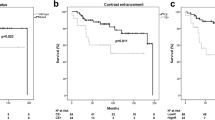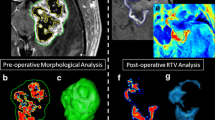Summary
Background
Differential diagnosis of unclear contrast-enhancing cerebral lesions includes cerebral metastases as well as malignant glioma. In the majority of cases, a definite preoperative diagnosis by neuroradiological assessment alone cannot be made. Since the introduction of 5-ALA-induced fluorescence-guided resection in the treatment of glioblastoma (GBM), the preoperative putative diagnosis of metastasis vs. GBM triggers a specific preoperative preparation of the patients. We analyzed the patient population with known cancer outside the central nervous system who underwent surgery for an assumed cerebral metastasis and for whom the intraoperative diagnosis was corrected to a malignant glioma.
Methods
Retrospective analysis of patients with a known primary cancer who were operated on for an assumed cerebral metastasis, which turned out to be a GBM. The patients were treated at our center between January 2008 and June 2011.
Results
We identified ten patients who underwent surgery for an assumed cerebral metastasis and for whom the diagnosis was corrected intraoperatively to a malignant glioma by frozen section. The median age was 68 years (41–82 years). The female-to-male ratio was 2:8. In all patients, the final histopathological analysis of the intracerbral tumors revealed a glioblastoma, while the patients suffered from diverse primary carcinomas.
Conclusion
A malignant glioma should always be considered as a differential diagnosis of an unclear contrast-enhancing cerebral lesion even for patients with a known malignancy. Furthermore, we make the case for a more liberal indication for 5-ALA.

Similar content being viewed by others
Reference
Baumert BG, Rutten I, Dehing-Oberije C, Twijnstra A, Dirx MJ, Debougnoux-Huppertz RM, Lambin P, Kubat B (2006) A pathology-based substrate for target definition in radiosurgery of brain metastases. Int J Radiat Oncol Biol Phys 66(1):187–194
Jenkinson MD, Haylock B, Shenoy A, Husband D, Javadpour M (2011) Management of cerebral metastasis: Evidence-based approach for surgery, stereotactic radiosurgery and radiotherapy. Eur J Cancer 47(5):649–655
Kamp MA, Grosser P, Felsberg J, Slotty P, Steiger HJ, Reifenberger G, Sabel M (2012) 5-Aminolevulinic acid (5-ALA)-induced fluorescence in intracerebral metastases: a retrospective study. Acta Neurochir(Wien) 154:223–228
Neves S, Mazal PR, Wanschitz J, Rudnay AC, Drlicek M, Czech T, Wustinger C, Budka H (2001) Pseudogliomatous growth pattern of anaplastic small cell carcinomas metastatic to the brain. Clin Neuropathol 20(1):38–42
Patchell RA, Tibbs PA, Regine WF, Dempsey RJ, Mohiuddin M, Kryscio RJ, Markesbery WR, Foon KA, Young B (1998) Postoperative radiotherapy in the treatment of single metastases to the brain: a randomized trial. JAMA 280(17):1485–1489
Patchell RA, Tibbs PA, Walsh JW, Dempsey RJ, Maruyama Y, Kryscio RJ, Markesbery WR, Macdonald JS, Young B (1990) A randomized trial of surgery in the treatment of single metastases to the brain. N Engl J Med 322(8):494–500
Pichlmeier U, Bink A, Schackert G, Stummer W (2008) Resection and survival in glioblastoma multiforme: an RTOG recursive partitioning analysis of ALA study patients. Neuro Oncol 10(6):1025–1034
Stummer W, Hassan A, Kempski O, Goetz C (1996) Photodynamic therapy within edematous brain tissue: considerations on sensitizer dose and time point of laser irradiation. J Photochem Photobiol B 36(2):179–181
Stummer W, Pichlmeier U, Meinel T, Wiestler OD, Zanella F, Reulen HJ (2006) Fluorescence-guided surgery with 5-aminolevulinic acid for resection of malignant glioma: a randomised controlled multicentre phase III trial. Lancet Oncol 7(5):392–401
Utsuki S, Miyoshi N, Oka H, Miyajima Y, Shimizu S, Suzuki S, Fujii K (2007) Fluorescence-guided resection of metastatic brain tumors using a 5-aminolevulinic acid-induced protoporphyrin IX: pathological study. Brain Tumor Pathol 24(2):53–55
Yoo H, Kim YZ, Nam BH, Shin SH, Yang HS, Lee JS, Zo JI, Lee SH (2009) Reduced local recurrence of a single brain metastasis through microscopic total resection. J Neurosurg 110(4):730–736
Conflicts of interest
None.
Author information
Authors and Affiliations
Corresponding author
Additional information
Comments
The 5-ALA method in microsurgical neuro-oncology—brought from the laboratory to the Zeiss operation microscope by Prof. Walter Stummer and his colleagues—is an important piece of European neurosurgically applied research and technical development. This raises the question of personal lifetime accomplishments that may pester aging technology-minded neurosurgeons.
Acta Neurochirurgica has reported on the growing clinical experience with the 5-ALA method, e.g., in malignant gliomas (1,2), intracerebral metastases and their unnoticed pink remnants in the operative cavity wall (3), stereotactic biopsy samples that become pink under blue light, which saves OR time from waiting for the frozen section diagnosis (4), and intracranial meningiomas, which raises the question which other benign tumors could become pink (5). There is also the important and open question of which non-neoplastic lesions will become pink—such as tumor-like MS lesions that open the blood-brain barrier and involve inflammatory reactions and infiltrating leukocytes (6).
In the present communication, the authors report brain lesions that looked like metastases in ten patients with previous cancer diagnoses that were GBMs instead and that the 5-ALA method should be used more liberally. Indeed, we use 5-ALA for any lesion that looks malignant or inflammatory with contrast uptake and requires histological verification.
Juha E. Jääskeläinen
Kuopio, Finland
1. Stummer W, Stepp H, Möller G, Ehrhardt A, Leonhard M, Reulen HJ (1998) Technical principles for protoporphyrin-IX-fluorescence guided microsurgical resection of malignant glioma tissue. Acta Neurochir (Wien) 140:995–1000.
2. Stummer W, Reulen HJ, Novotny A, Stepp H, Tonn JC (2003) Fluorescence-guided resections of malignant gliomas--an overview. Acta Neurochir Suppl 88:9–12.
3. Kamp MA, Grosser P, Felsberg J, Slotty PJ, Steiger HJ, Reifenberger G, Sabel M (2012) 5-Aminolevulinic acid (5-ALA)-induced fluorescence in intracerebral metastases: a retrospective study. Acta Neurochir (Wien) 154:223–8; discussion 228.
4. von Campe G, Moschopulos M, Hefti M (2012) 5-Aminolevulinic acid-induced protoporphyrin IX fluorescence as immediate intraoperative indicator to improve the safety of malignant or high-grade brain tumor diagnosis in frameless stereotactic biopsies. Acta Neurochir (Wien) [Epub ahead of print]
5. Coluccia D, Fandino J, Fujioka M, Cordovi S, Muroi C, Landolt H (2010) Intraoperative 5-aminolevulinic-acid-induced fluorescence in meningiomas. Acta Neurochir (Wien) 152:1711–9.
6. Nestler U, Warter A, Cabre P, Manzo N (2012) A case of late-onset multiple sclerosis mimicking glioblastoma and displaying intraoperative 5-aminolevulinic acid fluorescence. Acta Neurochir (Wien) [Epub ahead of print]
Rights and permissions
About this article
Cite this article
Kamp, M.A., Santacroce, A., Zella, S. et al. Is it a glioblastoma? In dubio pro 5-ALA!. Acta Neurochir 154, 1269–1273 (2012). https://doi.org/10.1007/s00701-012-1369-2
Received:
Accepted:
Published:
Issue Date:
DOI: https://doi.org/10.1007/s00701-012-1369-2




